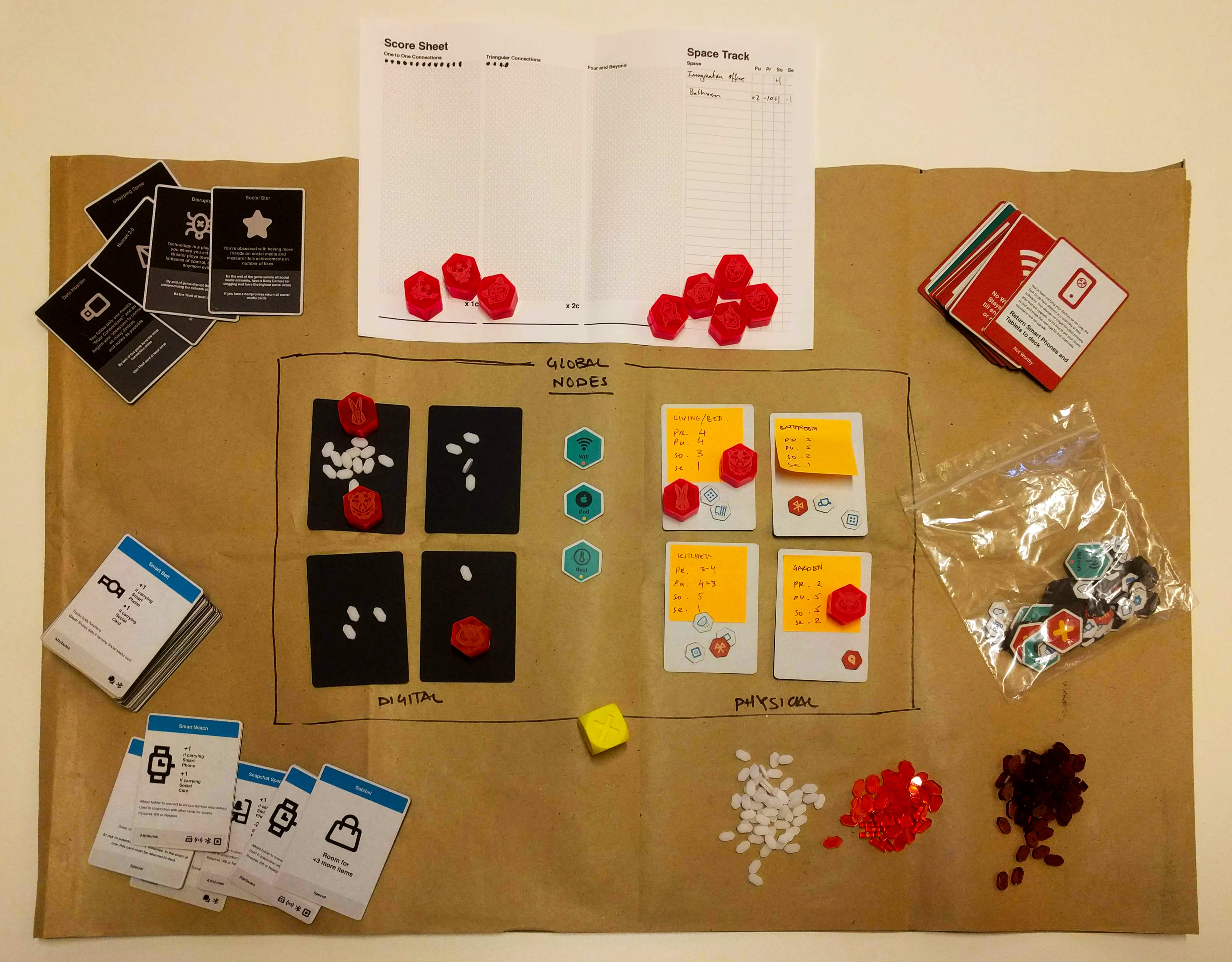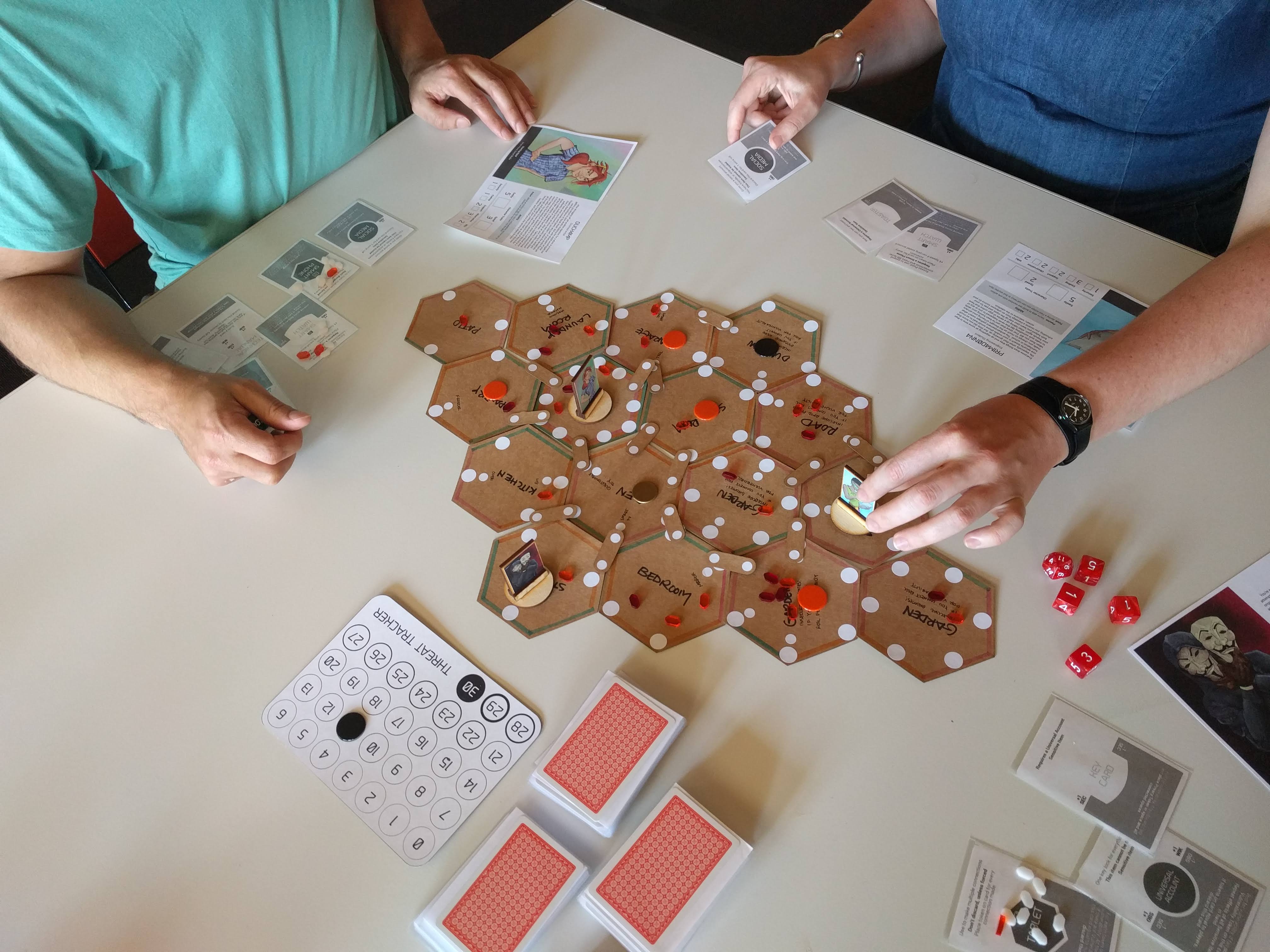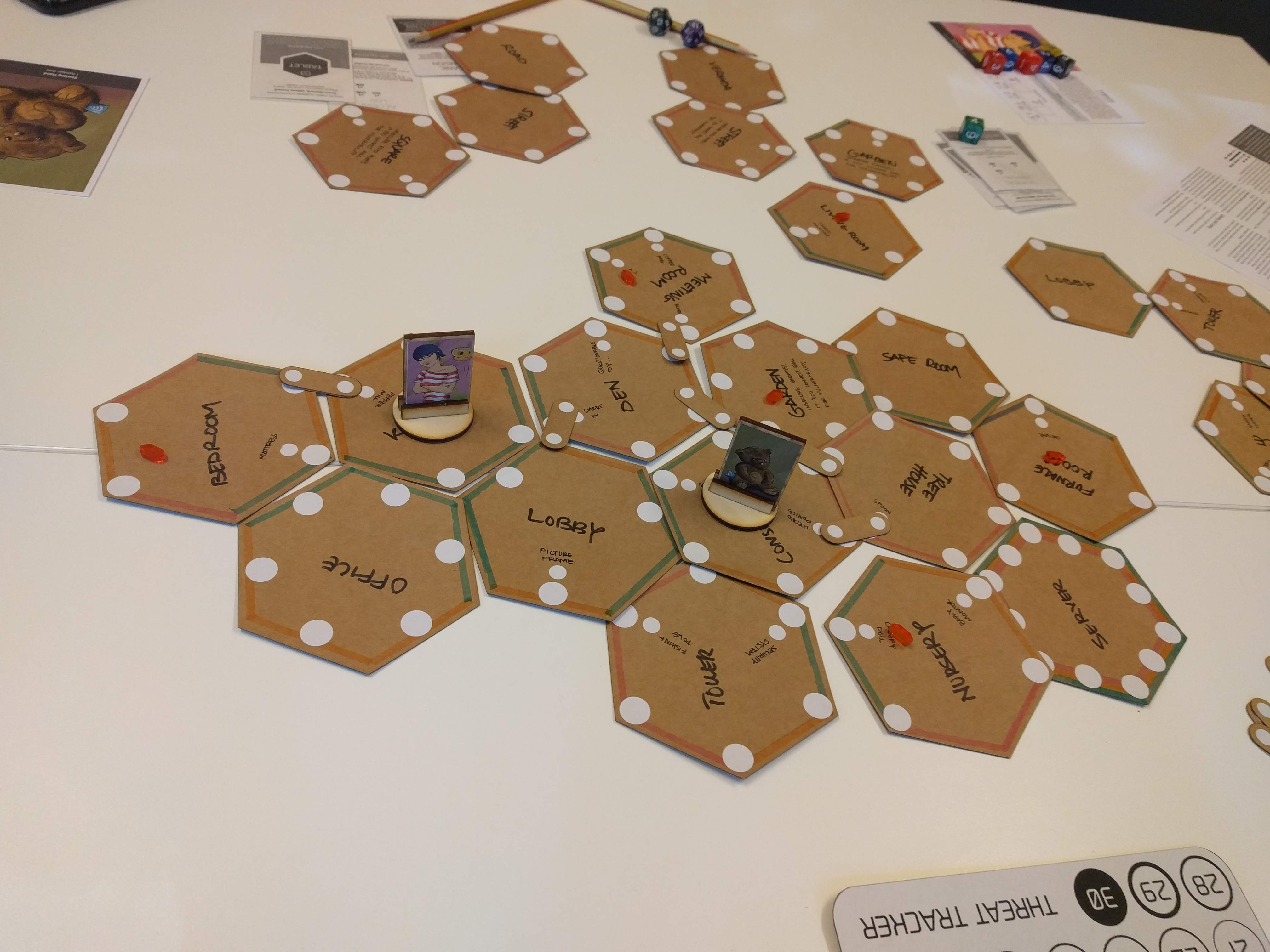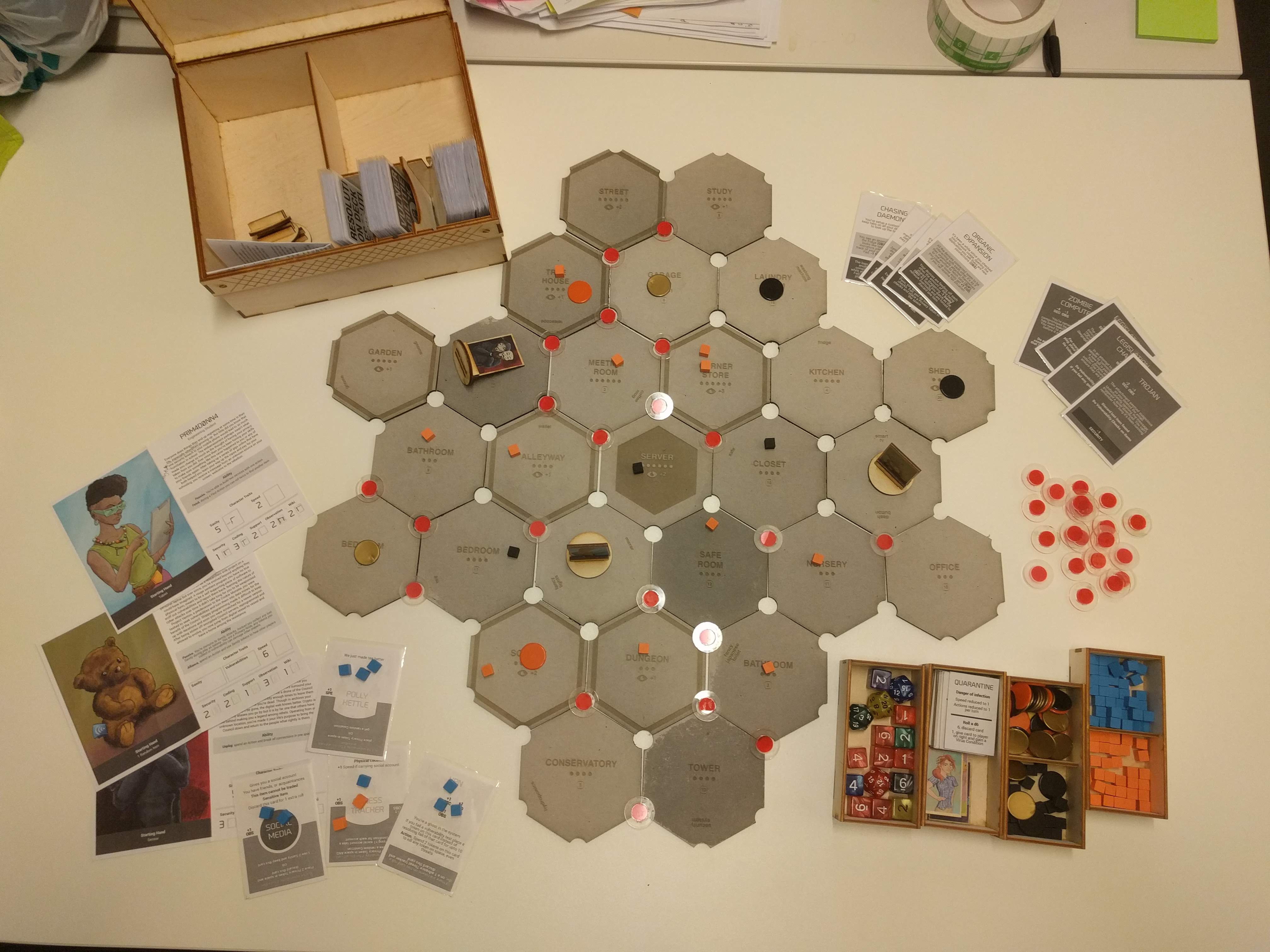Internet of Things Board Game
Playfully experiencing the Internet of Things
Premise
Having developed a framework for viewing IoT as possible spatial configurations, the question turned towards how much of this philosophical research was possible to experience first hand? The end product is part of my PhD thesis exploring play as a medium for design intervention. This artefact intends to present the concept of IoT as spatial configurations through gameplay in a designed board game.
Challenges
- Is it possible to express IoT as spatial configurations through play?
- Can a playable artefact balance philosophical research intents with playability?
Methodology
- Research through Design
- Philosophical Carpentry
- Game Design
- Procedural Rhetoric
- Specualtive Design
Overview
The spatial configurations of IoT presented an abstract means of viewing interactions within IoT spaces from a non-anthropocentric perspective. Applying the framework to a designed object presented its own challenges as on the one hand it could effectively describe interactions, but experiencing them was a different matter. As the research was heavily shrouded in philosophical discourse, knowledge translation into simpler means was necessary and for that the medium of play became the focus. The Internet of Things Board Game allows for understanding our interconnected digital world further through alternative more-than-human perspectives (image appropriated from upklyak︎︎︎).
The Internet of Things Board Game allows for understanding our interconnected digital world further through alternative more-than-human perspectives (image appropriated from upklyak︎︎︎).Two factors are important in this artefact: rhetoric and play. Both overlap through gameplay to facilitate an understanding of what occurs in the constellation of connected IoT objects. The game employs a unique procedural rhetoric1 established through gameplay that encourages players to see their relationships with these devices differently. To achieve this a Research through Game Design (RtGD) method was exercised, one that was influenced by accepted models of game design such as tandem game design.2 This way the design process shifted between a delineation of goals and the practice of designing a game. This echoes the efforts that went into creating this artefact where a balance between research intent and playability had to be achieved, a re-framing of approach step in the process.
Explaining the entire process of the design of a board game is both tedious and difficult particularly when the game employs procedural rhetoric in such a way as this artefact. This is because it is only through playing the game that a player can understand the rhetoric. Adding to that the incremental nature of the design process associated with games makes it even harder to do justice to this expression of how the game was designed. What follows is thus a brief account of the game and some aspects of its procedural rhetoric. A more detailed account is available in Chapter 8 and Appendix B of my PhD thesis.
 An iterative research through game design approach was adopted for this artefact similar to tandem game design.
An iterative research through game design approach was adopted for this artefact similar to tandem game design.Carpentry of the Internet of Things Board Game
The Internet of Things Board Game is a work of philosophical carpentry that attempts to indulge in a concept of constellations for IoT through gameplay. It was designed over 14 iterations3 which attempted to balance it as both a philosophical design research artefact and a playable game.In its final iteration the game has players collaboratively work at securing non-digital spaces where insecure digital interactions may be occurring. Players move between game tiles depicting spaces such as living rooms and kitchens where they collect IoT-enabled objects capable of interacting with digital spaces through commonly understood protocols such as Wi-Fi and Bluetooth. The game employs a fictional backstory to situate play where a data hungry corporation is attempting to extract data from average users. The players are part of a coalition working against the corporation in order to create their own secure spaces where they are in control of their data. Each player has their own set of skills which they use in conjunction with the IoT-enabled objects they carry with some objects affecting their skills.
The game attempts to disrupt the order of play by forcing players to assess the levels of risk their actions may have undergone through a phase-based play. Players first play out actions then are instructed to assess those actions using a dice roll. Various factors allow for players to navigate this assessment successfully, but if they fail certain consequences are faced. The game actively attempts to stop players from creating secure locations by dropping tokens identifying vulnerabilities and threats in the network. All the while as players create further interactions in-game they facilitate spatial configurations of digital/non-digital spaces depicted by connected physical game tiles. The game is won after a certain number of spaces have been secured, and being a collaborative game it can be lost if a number of different situations arise such as too many vulnerabilities and threats in the network.
 Overview of different design choices across iterations.
Overview of different design choices across iterations.The design of the game went through 3 core stages, an exploration, reflection, and a redux phase. The game takes inspiration from popular mainstream board games like Dead of Winter︎︎︎, Betrayal at House on the Hill︎︎︎, and Eldritch Horror︎︎︎. Though it takes mechanics and influences from these sources, the end result is unique to the artefact and the framework of spatial configurations the artefact intends to exercise.
In the many nuances of play the game allows for seemingly obscure scenarios to emerge such as players exclaiming, “I’m about to connect the Living Room to the Kitchen with my Shoes!”.
This entire journey of carpentering a board game from scratch could only be realised through the iterative process afforded by RtD. The possibilities that emerge for discussions around the alternative natures of IoT spaces facilitated by the game are vast. Below are a few images from the development of the game and its different assets.





Research presented at
DiGRA 2020, Tampere, Finland
RTD 2019, Delft, Netherlands
LIOT 2019, London
In Journal Publication
Acta Ludologica Summer 2021
Open Philosophy 2020
DiGRA 2020, Tampere, Finland
RTD 2019, Delft, Netherlands
LIOT 2019, London
In Journal Publication
Acta Ludologica Summer 2021
Open Philosophy 2020
Further links
The game is available for purchase (maybe)
Acta Ludologica 2021︎︎︎
Proceedings of DiGRA 2020︎︎︎
Read at Open Philosophy︎︎︎
Proceedings of RTD 2019︎︎︎
Proceedings of LIOT 2019︎︎︎
Acta Ludologica 2021︎︎︎
Proceedings of DiGRA 2020︎︎︎
Read at Open Philosophy︎︎︎
Proceedings of RTD 2019︎︎︎
Proceedings of LIOT 2019︎︎︎
︎
- Bogost, Ian. Persuasive Games: The Expressive Power of Videogames. MIT Press, 2007.︎︎︎
- To, Alexandra, Elaine Fath, Eda Zhang, Safinah Ali, Catherine Kildunne, Anny Fan, Jessica Hammer, and Geoff Kaufman. ‘Tandem Transformational Game Design: A Game Design Process Case Study’. In Proceedings of the International Academic Conference on Meaningful Play, 2016.︎︎︎
- The iterations are listed as per my thesis, though I do plan to return to the game at some point in the future (possibly for a retail version).︎︎︎
